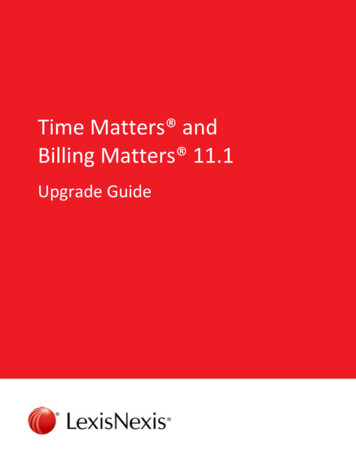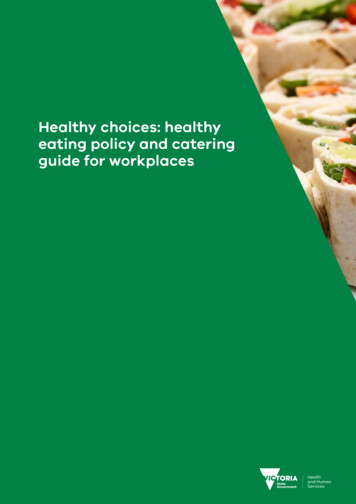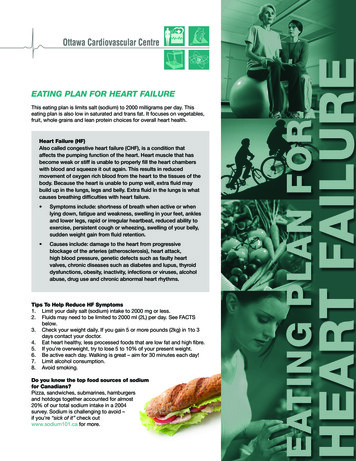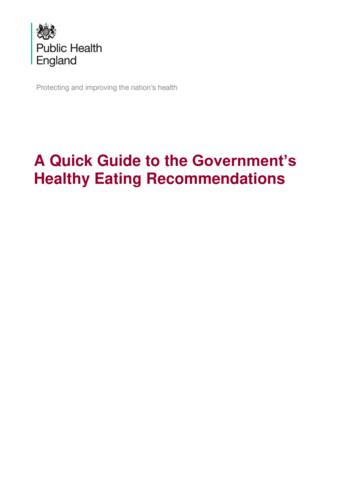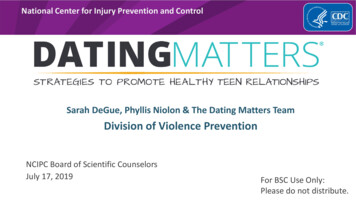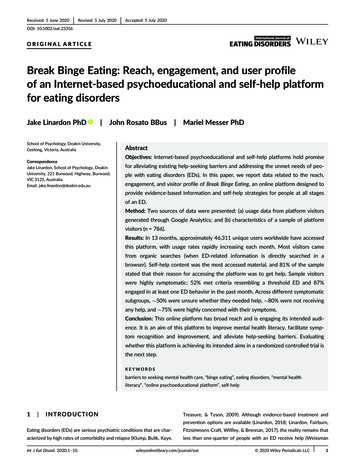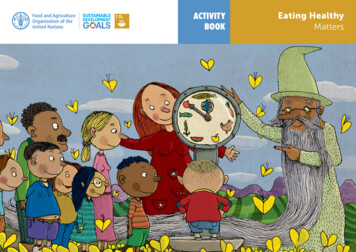
Transcription
ACTIVITYBOOKEating HealthyMatters
Required citation:FAO. 2019. Activity Book - Eating healthy matters. Rome. 24 pp.Licence: CC BY-NC-SA 3.0 IGO.The designations employed and the presentation of material in this informationproduct do not imply the expression of any opinion whatsoever on the part of theFood and Agriculture Organization of the United Nations (FAO) concerning the legalor development status of any country, territory, city or area or of its authorities, orconcerning the delimitation of its frontiers or boundaries. The mention of specificcompanies or products of manufacturers, whether or not these have been patented,does not imply that these have been endorsed or recommended by FAO in preferenceto others of a similar nature that are not mentioned.The views expressed in this information product are those of the author(s) and do notnecessarily reflect the views or policies of FAO.ISBN 978-92-5-131475-3 FAO, 2019Some rights reserved. This work is made available under the Creative CommonsAttribution-NonCommercial-ShareAlike 3.0 IGO licence (CC BY-NC-SA 3.0 3.0/igo/legalcode/legalcode).Under the terms of this licence, this work may be copied, redistributed and adapted fornon-commercial purposes, provided that the work is appropriately cited. In any use ofthis work, there should be no suggestion that FAO endorses any specific organization,products or services. The use of the FAO logo is not permitted. If the work is adapted,then it must be licensed under the same or equivalent Creative Commons licence. If atranslation of this work is created, it must include the following disclaimer along withthe required citation: “This translation was not created by the Food and AgricultureOrganization of the United Nations (FAO). FAO is not responsible for the content oraccuracy of this translation. The original [Language] edition shall be the authoritativeedition.”Disputes arising under the licence that cannot be settled amicably will be resolved bymediation and arbitration as described in Article 8 of the licence except as otherwiseprovided herein. The applicable mediation rules will be the mediation rules of the WorldIntellectual Property Organization http://www.wipo.int/amc/en/mediation/rules and anyarbitration will be conducted in accordance with the Arbitration Rules of the UnitedNations Commission on International Trade Law (UNCITRAL).Third-party materials. Users wishing to reuse material from this work that is attributedto a third party, such as tables, figures or images, are responsible for determiningwhether permission is needed for that reuse and for obtaining permission from thecopyright holder. The risk of claims resulting from infringement of any third-partyowned component in the work rests solely with the user.Sales, rights and licensing. FAO information products are available on the FAO website(www.fao.org/publications) and can be purchased through publications-sales@fao.org. Requests for commercial use should be submitted via: www.fao.org/contactus/licence-request. Queries regarding rights and licensing should be submitted to:copyright@fao.org.A note for educators:This Activity Book is aimedat a broad age range ofyoung people interested inlearning more about healthydiets and entering the 2019World Food Day PosterContest. Although it couldbe considered in certaincontexts for 8-12 year olds,it could also be used toteach both younger andolder students.
It’s all about foodHi there! My friend, the Zero Hunger mascot, broughtme here to talk to you about healthy diets and nutrition.She and I work side by side every day to make sure thateveryone knows how important food really is.Since 1945, every 16 October we celebrate World FoodDay on FAO’s birthday and because there’s SO MUCHto talk about when it comes to food, FAO choosesa different topic each year. Together this year, we’lldiscover how to be more aware of what you eat andmake sure that you have a healthy diet.Food is FAO’s business, and every day it helps over 130countries around the world to fight hunger and poverty,make sure that people eat nutritious food, and bettermanage their natural resources. FAO works mostly inrural areas, where nearly 80 percent of the world’s poorand hungry people live. Because food is everyone’sbusiness (not just FAO’s), over 150 countries across theworld celebrate with us to raise awareness about hungerand about how important it is that everyone has enoughsafe and nutritious food to lead healthy and active lives.Follow me through the pages of this book to find outhow you can help FAO to make sure that we reach ZeroHunger by 2030!3
Choosingwhat we eatWFD2019Poster ContestEATING HEALTHYIS YOUR BUSINESS TOO!Design a poster and show us your ideas about thisyear’s World Food Day theme. Tell us how you canimprove your diet and what we all need to do to makesure everyone everywhere can have a healthy diet too.Remember that your voice and actions count towardsbuilding a Zero Hunger world.To submit your poster, go to:www.fao.org/WFD2019/contestThe contest is open to 5-19 year olds and thedeadline for entries is 8 November 2019.Three winners from each age category will beselected by our jury and announced on the WorldFood Day website and on FAO’s social mediachannels. Winners will receive a certificate ofrecognition and a surprise gift bag, and will bepromoted by FAO offices all over the world.4Every creature and plant on our planet needs food to live,grow and reproduce. It’s also a basic human right. Everyone of us should always be able to get the food we needto live healthy and active lives.We choose the food we eat based on many differentthings: the time we have to cook or eat it, what’s easiest toeat, what others eat, the occasion, our culture or religion,what we like or dislike, our habits, and our knowledge andcooking skills too. But two very important things help us todecide what we eat: how much it costs and how easy it isto find.Have you noticed that junk food is very easy to find almosteverywhere you go? That’s because in the last few yearsjunk food has become more and more popular, and it’s alsonormally cheap. Eating more junk food means that ourdiets have changed a lot, and not for the better. Junk foodhas ‘junk’ in the name for a reason: some of it is bad forthe planet because of how it’s made, and it’s also bad foryou (full of sugars, fats, salt and other unhealthy things).Not eating a variety of enough nutritious food can lead tohealth problems and sickness, and in this book I will tell youwhat you and others can do to avoid this.Two very important things helpus to decide what we eat:how much it costs and howeasy it is to find.
My food story1. Think about yesterday. What did you eat, when and with whom?4. What do you think is nutritious, what’s not? Fill in the table belowand ask your parent or teacher if they agree.NUTRITIOUSJUNKSOMEWHEREIN THE MIDDLE!2. Why did you choose those specific foods?3. What do you normally eat every day? Ask your parents, teachersand friends the same questions. What did they eat?5
The ABC ofhealthy dietsBeing healthy is everyone’s responsibility, including yoursand your parents. Aside from getting enough exerciseand drinking enough water, a very important part of beinghealthy is having a good diet. A healthy diet means eatingenough nutritious, safe and varied food every day so thatyou can grow and live an active life (run, play, learn, growand climb trees).An unhealthy diet can lead to illness and even death. Didyou know that today, one in five deaths around the world iscaused by unhealthy diets? This can happen when peopledon’t eat enough fruit, vegetables and legumes, andinstead eat too many foods that are high in sugar, fat orsalt. So healthy diets are a really big deal.A healthy diet is a balanced one, and it’s really important totry to include the right amount (not too much or too little!)of different foods to get enough of what your body needsto work well (like nutrients, such as vitamins, minerals andother important things). Here are the different ingredients(AKA food groups) that make up a healthy diet.Knowledge is health, not just power!Being healthyis everyone’sresponsibility6Fruit and vegetables:fruit and vegetables give us vitamins, minerals,fibre and natural sugars. You should eat asmany seasonal fruit and vegetables as possibleevery day.Cereals:this group contains everything made fromwheat, rice, oats, maize, barley or other grains.They are called ‘staple’ foods as they are eatenevery day. They contain carbohydrates, whichare your main source of energy.Tubers and plantains:these include potatoes, yams, sweet potatoes,cassava, and malanga, and they too are asource of carbohydrates, vitamins and minerals.Plantains (like bananas but not very sweet)are also an important staple food in manycountries.
Legumes and nuts:Meat, fish and eggs:legumes (fresh peas,beans or lentils), nuts,seeds and soybeanproducts are crucialsources of proteins.They come from plants,cost less than otherprotein-rich foods, arehigh in fibre, low in fat,and have other keyminerals and vitamins.everything made frommeat, poultry (chicken,duck, turkey, ostrich, etc.),fish, seafood and eggsbelongs in this group. Allthese foods contain ironand proteins, which arewhat make you strongand help to fix your bodywhen you get hurtDairy products:Fats and oils:these are all made frommilk (cow, goat, sheep,buffalo, camel, yak,horse and even moose)and include milk,cheese, yoghurt, curd,and buttermilk. Theyhave plenty of calcium,protein and fat.your body needs theright kind and theright amount of fatsand oils to be healthy.Choose vegetableoils, nut butters andavocado over fats inmeat, butter, cream, orpalm oil, and avoid friedfoods high in fats.YOUR TURN:Each country has its own definition of a healthy diet and ways to group their foods. Have you ever seen a foodpyramid or a healthy plate? This can change depending on what foods are available, and nutrition problems inyour country. Look up food-based dietary guidelines on the FAO website and see if you can find what a healthydiet or healthy eating means for your country.7
Nutrition and the SDGsThere’s a whole Activity Book dedicated to Zero Hunger, but for those of you joining usfor the first time, Zero Hunger means bringing the number of people who suffer fromhunger and malnutrition (e.g. people who are over- or underweight) to ZERO.Zero Hunger is the name of FAO’s most important operation.Zero Hunger is the second of the United Nations’ 17 SustainableDevelopment Goals (SDGs), all of which we have to reach by 2030 if wewant the world to become a happy and safe place for everyone. If wedon’t achieve Zero Hunger (SDG2), reaching the other goals will be very,very difficult because each goal depends on it.I’m sure you’ve already made the connection, but just in case nutrition is aBIG part of the Zero Hunger Goal. Zero Hunger is not just about people havingenough food, it’s about healthy eating too, because as the saying goes: you arewhat you eat.And while we’re still talking about what you eat, there are other SDGs that have asay. They are: Quality Education (SDG4), Good health and well-being (SDG3) andResponsible consumption and production (SDG12). It’s pretty straightforwardreally: First, we all need to learn about healthy diets so we can be more carefulabout the food we grow, produce, eat and throw away. These choices don’t justaffect OUR health, they affect the health of our planet too. If the food we eatis nutritious, but was grown using too much fertilizer or pesticides, it’s notthat healthy for us or for the soils and water that absorb them. The way wegrow our food needs to change to make sure we have enough resourcesfor the future (when there will be MANY more mouths to feed), and thatthe planet doesn’t suffer for it.YOUR TURN:Why do you think nutrition is important? And whydo we need to learn about it? Find out more aboutSDG4 and the other SDGs by visitingwww.worldslargestlesson.globalgoals.org8
Time forchange50 years ago the world was worried abouthow to feed everyone, so a plan wasmade to grow as much food as possible,as quickly as possible. It was called theGreen Revolution, and it was successful.But it came at a big price. Many nutritiouscrops were pushed aside to make roomfor a small number of crops that grewfast, produced more and brought in moremoney. In the process, a lot of naturalresources (soil, forests, water) were used,which had a negative effect on air andsoil quality as well as biodiversity. We’restill growing a lot of our food based onthis method today, which means thatwe’re not thinking about the future of ourplanet, which is suffering. And this needsto change.We now know that we don’t just haveto grow a LOT of food, it has to beNUTRITIOUS food. And we have to thinkabout our planet by being careful aboutwhat we grow and how we grow it. Didyou know that there are more obese andoverweight people in the world than thereare people who suffer from hunger? It’snot just about feeding hungry people, it’salso about making sure that everyoneis able to easily find and buy nutritiousfood. We also need the skills and tools tochoose our food more carefully and makesure that what we’re eating is nutritious.It’s time for a Healthy Diet Revolution!9
The same person canexperience hunger andobesity at differentstages of their life.Problems caused bymalnutrition exist in allcountries and can affectboth rich and poor.DID YOU KNOW?In many countries,people don’t eatenough fruit andvegetables. Eatingplenty of these canhelp to prevent manydiseases, includingdiabetes and cancer.10Most of the world’s population live incountries where overweight and obesity killmore people than hunger.
Having a variety of differentcrops –some that growquickly, others that needlittle water, or do well inhigher temperatures– isgood for us, the planet andcan help us to fight climatechange too!Not feeling hungry doesn’t mean that you’regetting all the nutrients you need. Even peoplewho can afford all the food they could eat maynot be getting the right nutrients Pulses like lentils,chickpeas or beansare a good sourceof protein, vitaminsand fibre and arelow in fat and salt.It takes little waterto grow them andthey make our soilshealthier!Less time is spentpreparing meals at home,which means that mealsare often less nutritious aspeople (especially in towns)rely on ready meals, fastfoods, and street foods.By readingfood labels, youcan see howmany vitamins,minerals, calories,fats, etc. are inthe food product.Remember thatthe words ‘light’ or‘zero’ don’t alwaysmean healthy.BROWN REVOLUTION:I mentioned the Green Revolution earlier, but did you know that there’s alsoa Brown Revolution? It’s all about the importance of healthy soils. Mostthings grow in soil, and our fresh water is found in the ground, so if our soil isunhealthy, polluted or full of chemicals, our food and water will be too. Healthysoils also mean more nutrients in our food!11
Find these objects!
What FAOis doingFAO works hard to improve nutrition and make sure that everyone, everywhere has ahealthy diet. It works to improve nutrition in three main ways:1. Planning it2. Growing itFAO works with governments and peoplewho make policies and laws (legislators)to make sure that they think about nutrition.If nutrition is included in a country’s plans,it’s easier to prevent malnutrition and mostof the other problems caused by unhealthydiets. This way it’s also easier to supportfarmers and producers to make sure thatthe food they grow or process is morenutritious.FAO works with farmers and producers ona strategy to grow and produce nutritiousfood with a bit of a complicated name:“nutrition sensitive agriculture”.It basically means growing and producingenough nutritious food. Good planningwith governments and legislators meansthat this food is then made available toeveryone who needs it, especially children.By available I mean that it should be foundeasily, and should not be too expensive sothat everyone can afford it.Remember your country’s “food-baseddietary guidelines”? This is another waythat FAO is striving to improve nutritionand spread the word about healthy eatinghabits. FAO does this by working with over100 governments around the world to guideand help them to decide what a healthy dietlooks like in their country and to create toolsthat people can use to improve their diets.14Apart from making nutritious food moreavailable, FAO also says that we needmore nutritious choices, which means thatfarmers should grow different foods sothat we don’t all depend on the same typeof food to keep us healthy. It also meansthat in some cases, food can be enrichedto MAKE it more nutritious, for example byimproving the health of the soil it’s grownin. And finally don’t forget that the wayfood is grown is really important! This wayof farming also means growing more whileusing less natural resources.
3. Teaching itTalking to grown-ups about food and healthy diets isn’tenough for FAO. FAO helps schools and universities toteach young people about healthy eating, because afterall, you are the grown-ups of the future! FAO does this infour ways. The first is through school food and nutritioneducation, which some of you may have heard of fromour books or because it was done at your school too. FAOhelps students, teachers, parents and others working inschools to learn about healthy diets. The idea is to changethe way everyone treats or thinks and feels about food bycreating learning materials (like this one), and showingschools how to grow fruit and vegetable gardens ininexpensive ways. The second way is to encourage andshow people how to grow nutritious food at home, givingthem the tools and seeds they need to feed themselvesand sell what’s left, often to local schools so they can cooknutritious meals. The third way is called ENACT, and itis a course that teaches university students how to givepeople the tools, knowledge and information they need toimprove their own diets. And the fourth way is by offeringfree online E-learning courses for university students andgrown-ups on a variety of topics, giving them the tools toimprove nutrition in their country.FAO is working hard with governments, farmers,producers, schools and universities as well as otherinstitutions to fight malnutrition in all its forms, but thereis something for EVERYONE to do. Read the next fewpages to discover what different people (including you)can do to help fight malnutrition!YOUR TURN:What does your school teach about healthy dietsand nutrition? Do you have a school garden?Have you used it to learn about healthy eating?15
Whatgovernmentscan doGovernments have a very important role to play inmaking sure that everyone has a healthy diet and is ableto lead a healthy and active life. There are five big thingsgovernments should do:1. Governments need to make laws or plans to improvenutrition in their country and to help make sure thateveryone (especially those who need it most, likechildren and future mothers) knows how to eat healthilyand can afford the right food. This can make a BIGdifference.2. They should also help and encourage farmers to growfood in ways that don’t hurt our planet. Happy planet,happy food, happy you.3. Being more strict about what food is sold is anotherway that governments can work to make sure thatpeople eat nutritious food. Food needs to be safe,nutritious and have clear labels, because if we havehealthy options and understand more about the amountof calories and the amount of fats, sugars and saltused, we can make healthier choices.4. Investing in teaching both youth and children abouthealthy eating is another way that governments canmake a difference.WHAT FARMERS CAN DO16Farmers should learn how it’s important to grow a variety of nutritious crops,such as fruits, vegetables, legumes and nuts. This can help to provide thenutritious food we need and do less damage to the environment.5. And last but not least, governments need to supportresearch efforts and fund more projects that workon improving or inventing technologies that can helpfarmers.
What theprivate sectorcan doFirst off, private sector is a word we use to avoid having to list a lot of different things.It is made up of enterprises of all sizes that sell services or products, from insuranceto advertising, and TVs to toys. The food sector includes businesses like bakeries,restaurants, supermarkets, big food manufacturers or any company related toagriculture and food. The private sector has the power to really make a difference bychanging the way companies do things. Have a look at a few of them below:1. Businesses and companies thatproduce, make or sell food need tooffer safe and nutritious food choicesthat help people to have a healthy diet.This means inventing new nutritiousproducts that have people’s health inmind, and putting limits on the amountof fats, sugars and salt in existing foodproducts.2. Companies should stop usingpopular cartoons, characters andadvertisements to convince childrenand youth that food high in fat, sugaror salt, are good. They should advertisenutritious food that helps us to growstrong and healthy.3. Companies that produce food need tostart putting clear information on foodlabels to help people to understandthem and make healthy choices. Haveyou ever tried to understand what’s on afood label? They’re full of strange wordsand it’s pretty difficult to understand ifit’s nutritious or not, right?4. The private sector should stop usingmisleading statements! Just because apacket of biscuits says it’s “high in fibre”(which is good for you), doesn’t meanthat it’s not “high in” fat or sugar too 17
Time to act!You, your parents, your teachers, friends and anyone youknow can do something to make sure you eat a healthydiet and lead a healthy life. Remember that good eatinghabits are only part of the solution. You also need to havea fit and active lifestyle – sit around less, get up, dance,walk or play outside! Here are a few tips on how to startchanging your eating habits.Snack healthily and say no to junk food!Choose one junk food that you would liketo eat less of (less quantity or less often)and make a plan. When you need a snack,try choosing a ripe fruit, raw veg, nuts orwhole grain bread rather than somethingpackaged and less nutritious!Follow the one third veg ruleFill up at least one third of your plate withvegetables during meals or try to eat an allveggie meal once a week. Include at leastone dark green and one orange or yellowvegetable a day, as they’re full of nutrients.Take action at schoolDo you have a school cafeteria or vendingmachine? Have a look at the food theyprovide. Are there enough fruit andvegetables? If not, talk to your teachersabout changing the food choices.Be a critical consumerBe critical of the advertising you see onTV and in social media. Ask yourself if thefood advertised is nutritious or not. Countthe number of advertisements you see ina day and discuss with your parents andteachers.18
Protect our planetReduce foods that are harder on our planet.This could include foods that need morenatural resources, especially water, toproduce (meat uses more than plants orpulses), fruit and veg that aren’t in seasonor local. And remember to buy food withless packaging!Choose local, varied, fresh and seasonalAsk your parents to buy local, seasonalfruit and vegetables and to choose freshover preserved or tinned foods. If you can,choose organic! Organic farming helps oursoils to stay healthy.Go from white to brownAsk your parents if they can swap refined“white” cereals for whole grains (brown rice,wholemeal flour and bread, etc.).Drinks matter tooDrink plenty of water if you can. Try toreduce sugar sweetened drinks that don’thave many nutrients in them.Help out in the kitchenWatch and learn as your parents cookmeals, and offer to help in the kitchen whenyou see that they’re tired. There are plentyof easy, quick and healthy recipes on theinternet to inspire you.Add variety with legumes, nutsand cerealsAsk your parents to experiment with youby adding different types of legumes (likelentils, chickpeas, peas and beans), nutsand cereals (like millet, barley, oats, brownrice) to family meals.19
Don’t let packaging fool youYou need to pay attention to the nutritiousvalue of food, not what it looks like, or howcool the packaging is. And look out forwords like ‘zero’, ‘low in’ and ‘light’. They’reoften used to make food sound morenutritious, and it isn’t always true Eat with your family or friendsHelp to prepare a meal with family orfriends at least once a week and eatit together. Eating in company is animportant way to enjoy meals and spendtime together.Eat local and traditionalAsk your parents, teachers and peoplein the market what nutritious food istraditional or local. See if you can try toinclude this food in your diet more oftento eat a varied diet and protect localvarieties of food.20Understand labelsAsk your teacher or parents to help withreading and understanding food labels.Take time to read the list of ingredientson a label and try to identify if the foodcontains too much salt, sugar or fat.
Activity PageYou might be thinking that hope is lost and that there isso much that you need to do to make sure everyone hasa healthy diet, but there are already a lot of great thingshappening!Some countries are creating labels that warn peopleabout high levels of salt, sugar or fats in food. Citiesare making sure that vending machines sell nutritiousfood. Schools are growing vegetables or sourcing freshfood from local farmers to make nutritious meals. TVshows are teaching people about healthy eating, andgovernments have created guidelines to help theircitizens to have a healthy diet. Many people all over theworld are working tirelessly to fight malnutrition.Now that you’ve read this book, it’s time to test yourknowledge!1. What is the Green Revolution and how do we have tochange things today?YOUR TURN:What are people doing in your country? Insteadof telling you about the Zero Hunger champions Iknow that work to improve nutrition, I want you totell me about one YOU know!Make a promise to yourselfChoose up to 3 actions to commit to and writethem in the space below. Get some inspirationfrom the actions in this activity book, or think ofsome of your own!2. Go to pages 12-13 and circle three examples of healthyliving or healthy eating. There are more than 8!3. Who is responsible for healthy diets? What can they do?Ask your parents if they can help you to achievethem and tell your friends and teachers about yourchoices too.21
Enter the World FoodDay poster contest!22Now that you understand how important healthy diets are has a healthy diet. Draw, colour or paint them in the Zeroand the role that everyone needs to play, we want to seeHunger bowl below. Scan or take a photo of your poster toyour ideas on how to make sure that everyone, everywhere participate in the contest: www.fao.org/WFD2019/contest
Eating HealthyMattersTips to remember:Don’t forget! Choose local, varied,fresh and seasonalNow that you have completed the Activity Book I want youto tear out this little card full of reminders about healthyeating. You can keep it with you or put it in the kitchen sothat your family can have a look at it too. Add variety with legumes,nuts and cereals Say no to junk foodand snack healthily Follow the one thirdveg ruleTEAR HERE Go from white to brown Help out in the kitchen Eat with your family Understand labels Don’t let packagingfool you Be a critical consumer Eat local and traditional Protect our planetMORE INFORMATION? Take action at schoolThe world of healthy diets is way too big to coverin just a few pages, so if you want to find out moreabout nutrition, vitamins, fibres, minerals, foodsafety and eating green, look up the FAO YUNGAbook on nutrition or the Eating well for good healthguide for teens on the FAO website! Drinks matter too
Activity Book SeriesYou can download the FAO Activity Book Series on our “Building the #ZeroHunger Generation” portal together witha range of material to support educators and parents in the preparation of activities or classes on important globalissues at the core of FAO’s work: www.fao.org/building-the-zerohunger-generation Your Guide to FAO Working for Zero Hunger Change the futureof Migration Climate is ChangingContact us:FOOD AND AGRICULTURE ORGANIZATIONOF THE UNITED NATIONSViale delle Terme di Caracalla00153 Rome, Italyworld-food-day@fao.orgwww.fao.orgISBN 978-92-5-131475-397 8 9 2 5 13 1 4 7 5 3CA4694EN/1/05.19
to live healthy and active lives. We choose the food we eat based on many different things: the time we have to cook or eat it, what’s easiest to eat, what others eat, the occasion, our culture or religion, what we like or dislike, our habits, and our knowledge and coo

